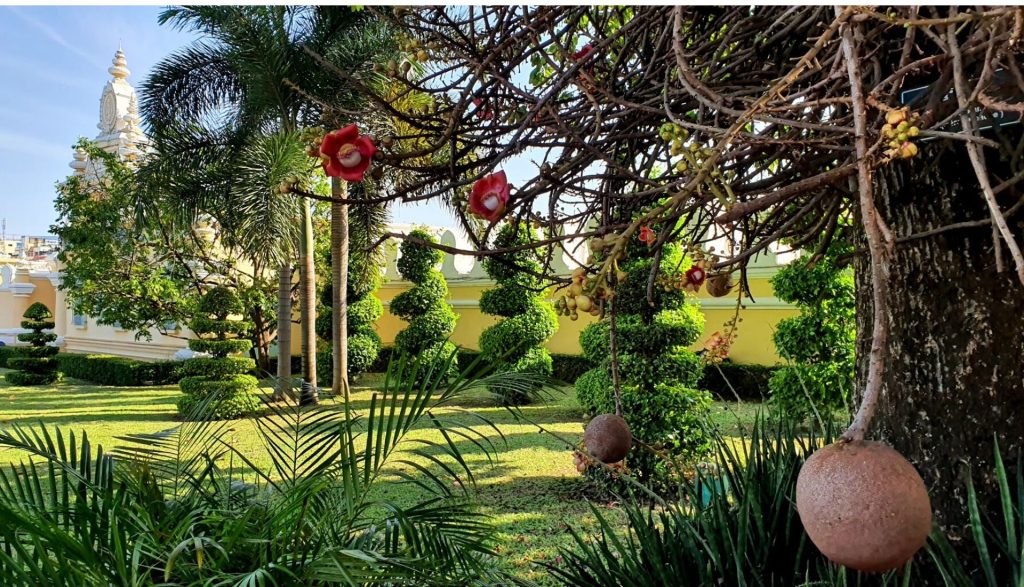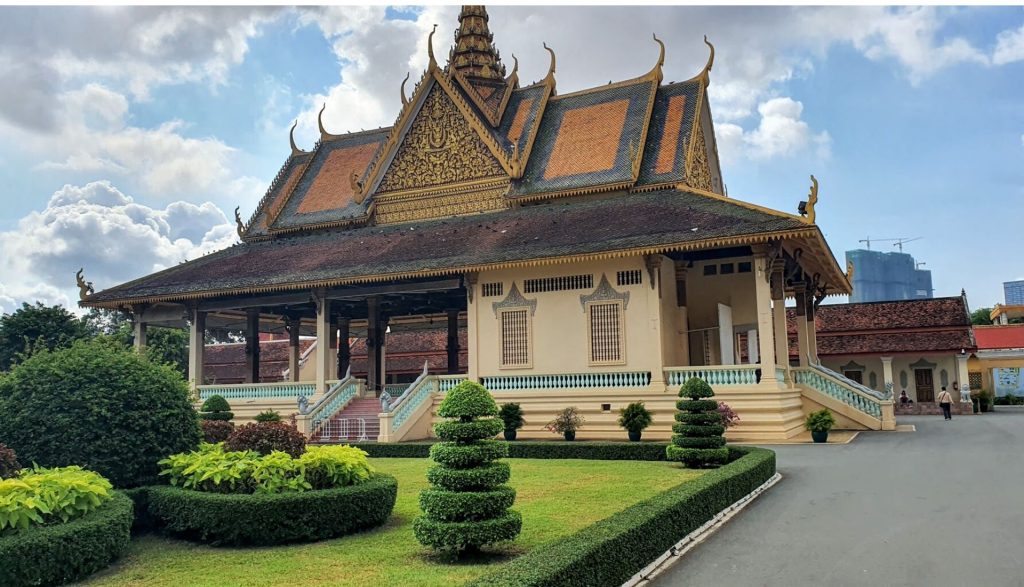What is Cambodia’s geographical location within Southeast Asia?
Cambodia is situated in Southeast Asia and shares borders with Vietnam to the east and southeast, Thailand to the northwest and west, Laos to the northeast, and the Gulf of Thailand to the southwest.
Phnom Penh is located in what city?
Phnom Penh Cambodia’s capital is situated at the confluence between the Mekong and the Tonle Sap, Tonle Bassac and Tonle Sap Rivers.
You can find out what to do in Phnom Penh
Phnom Penh is a city that will keep you busy for at least four days.
1.Phnom Penh’s Royal Palace is a must-see
One of Phnom Penh’s most popular tourist attractions is the Royal Palace, and adjacent Silver Pagoda. We recommend you arrive early in order to avoid the crowds.
The Royal Palace, the Silver Pagoda and their opening hours are: 8.00-11.00 daily and 14.00-1700 except on Sunday.
Entry Fee: USD 10.00
Guide Cost: US$10.00. (We highly recommend buying a guide).
The Royal Palace has certain regulations regarding visiting it:
You cannot:
- Wear shoes in places of worship
- Wear hats in the Silver Pagoda and Royal Palace
- Dressed incorrectly
- Take photos at prohibited locations
- Touch the glass panel of an item displayed within
- Touch murals
- Smoking is prohibited in Silver Pagoda or the Royal Palace area
The complex consists of four compounds:
- Central compound – Throne Hall
- North compound of Khemarin Palace
- South compound – Silver Pagoda
- West compound – Inner court

The Cannon Ball Tree is sacred for Hindus. Many Buddhists revere the tree around the globe, believing that Maya held on to one of its branches while giving birth.
It can reach a height of 35 meters and produce up to 1000 pinkish red flowers per day. Round fruits, which resemble cannonballs, can reach a height of 25 cm. The flower blooms are used to make a tea that is said to be beneficial for giving birth.
The Treaty of Protection was signed by King Norodom in 1863 (the great-great grandfather of today’s King Norodom Sihamoni). The French Protectorate built the Royal Palace in 1866, designed by architect Neak Okhna Tepnimith Mak.
It is also used to celebrate Coronation Ceremonies and New Years Day, as well as official meetings, the anniversary of Coronation Day, and other events. It was built in 1917. This is the 2nd Throne hall on this site.
Travel Tip : The best time for taking photos of the Throne Hall in the morning. The Throne Hall and the thrones are only visible from the outside.
The King represents Buddha in Cambodia. On his coronation, the King is only allowed to sit on Preah Tien Bossabok. He will only use the smaller throne in front of the traditional one for special occasions.
After his father’s 2004 abdication, the current King Norodom Sihamoni lives more like a Buddhist.
2.Phochani Pavilion Phnom Penh

In 1912, the Phochani Pavilion was constructed as a dance hall. It is now used as a venue for meetings and royal receptions.
3.The Silver Pagoda Phnom Penh

Silver Pagoda, a complex of temples within the Royal Palace grounds. Wat Preah Keo Morokot is also known as Temple of the Emerald Buddha.
The floor is made up of 5,329 tiles, but they are covered in plastic. Each tile weighs 1 kg. The Silver Pagoda is a photo-free zone.
Silver Pagoda, where the Monks preach to the King and the Royal Possessions are held.
Over 2000 diamonds are found in the 17th century Emerald Buddha, located within Silver Pagoda.
Murals that surround the complex tell the Ramayana story. Poland has helped renovate the murals. The murals were painted between 1903 and 04 and are 604.m long and 3.5m high.
Stupas within the complex are ashes from a king, one stupa per king.
4.Royal Regalia Building Phnom Penh
The Royal Regalia Building contains the Royal Bodyguard costume as well as gold costumes used during King and Queen Ceremonies.
All staff wear traditional rainbow colours for their ceremonial skirts. The same color skirt is worn by all staff members, both men and women.
